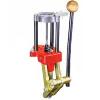I started reloading with a Lee Loader in 38 Special many years ago and now have 8 kits (along with 4 presses, 14 die sets, and 1,32 metric tons of assorted reloading tools). I like Lee Loaders and perhaps because of my machinist/mechanic background I have experienced none of the "problems" the the OP has. And as often incorrectly posted, not all Lee Loaders are neck sizing only. Straight sided cases are full length sized. bottle necked cases neck sized. For not being able to fully size a 45 ACP case, the tool needs a solid base/anvil and a mallet heavy enough to fully push the case into the die (so far the hardest case I've found to size is 44 Magnum case previously loaded to near max). A "dead blow" hammer, 16-24 oz. works great and some lube may be helpful. A block of wood works fine for a base/anvil (I started with a 6" log about 24" long). I can't see why one would find pounding a brass, closed end tube into a steel tube "impossible", but some may find it difficult. I solved the primer popping problem by lightly chamfering the primer pocket mouth, just like decrimping military primer pockets. I haven't popped a primer in many, many reloads.
I'd suggest wiping each case with a solvent dampened rag, use a bit of lube (I have used Mink Oil Boot Dressing Cream for many, many years and have never stuck a case), using a suitable mallet (I have used 8 oz plastic mallets, 16 oz. leather mallet, and a 24 oz dead blow hammer) and set the die on a sturdy surface (I have used 4x4 blocks on end, a leather pad on the bench top and for harder to size cases a lead ingot). Make sure the mallet hits the case square and the die is straight and supported. Should work...
Hint; never use a steel hammer or steel anvil. The Lee Loader won't last very long using steel against steel.
I'd suggest wiping each case with a solvent dampened rag, use a bit of lube (I have used Mink Oil Boot Dressing Cream for many, many years and have never stuck a case), using a suitable mallet (I have used 8 oz plastic mallets, 16 oz. leather mallet, and a 24 oz dead blow hammer) and set the die on a sturdy surface (I have used 4x4 blocks on end, a leather pad on the bench top and for harder to size cases a lead ingot). Make sure the mallet hits the case square and the die is straight and supported. Should work...
Hint; never use a steel hammer or steel anvil. The Lee Loader won't last very long using steel against steel.





